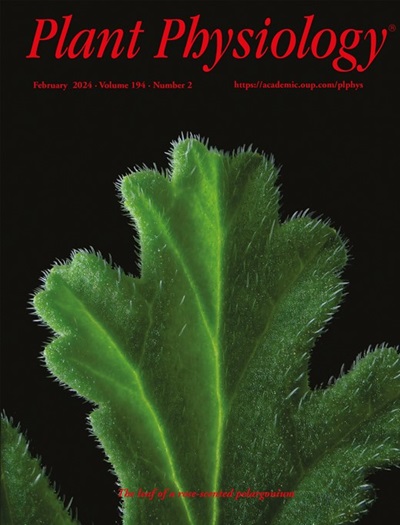易感因子RTP1通过与细胞色素P450蛋白CYP71B3相互作用负向调节拟南芥免疫
IF 6.9
1区 生物学
Q1 PLANT SCIENCES
引用次数: 0
摘要
卵菌,特别是疫霉,会引起毁灭性的植物病害,严重威胁作物的可持续生产。由于基因型特异性抗病性的丧失,鉴定和了解介导植物易感性的免疫因子是很重要的。抗性因子RTP1功能缺失导致拟南芥(Arabidopsis thaliana, L.)具有广谱抗病能力。Heynh)。通过RNA-seq分析,我们确定了CYP71B3编码一种未被鉴定的P450酶,在感染了寄生蜂的rtp1突变植株中显著上调。CYP71B3的功能丧失导致病原体相关分子模式(PAMP)触发的氧化爆发被废除,并使拟南芥更容易受到多种病原体的影响,包括卵菌P.寄生虫和细菌丁香假单胞菌。相反,CYP71B3的过表达增强了植物的抗性和pamp引发的氧化爆发。CYP71B3定位于内质网,并通过I-38残基与RTP1相互作用而不稳定,这对其免疫功能和P450酶活性至关重要。CYP71B3的表达受转录因子bZIP60的调控,这是rtp1介导的对寄生的抗性所必需的。我们的研究表明,RTP1通过破坏下游阳性免疫因子CYP71B3的稳定来介导植物的易感性。本文章由计算机程序翻译,如有差异,请以英文原文为准。
The susceptibility factor RTP1 negatively regulates Arabidopsis immunity by interacting with the cytochrome P450 protein CYP71B3
Oomycetes, particularly Phytophthora species, cause destructive plant diseases that severely threaten sustainable crop production. Due to the loss of genotype-specific disease resistance, it is important to identify and understand immune factors that mediate plant susceptibility. Loss-of-function of the susceptibility factor Resistance To Phytophthora parasitica 1 (RTP1) leads to broad-spectrum disease resistance in Arabidopsis thaliana(Arabidopsis thaliana (L.) Heynh.). Through RNA-seq analysis, we determined that CYP71B3, encoding an uncharacterized P450 enzyme, is significantly up-regulated in rtp1 mutant plants infected with P. parasitica. Loss-of-function of CYP71B3 led to abolished pathogen-associated molecular pattern (PAMP)-triggered oxidative burst and rendered Arabidopsis more susceptible to diverse pathogens, including the oomycete P. parasitica and bacterial Pseudomonas syringae. Conversely, overexpression of CYP71B3 enhanced plant resistance and PAMP-triggered oxidative burst. CYP71B3 localized in the endoplasmic reticulum and was destabilized by interacting with RTP1 via the I-38 residue, which is essential for its immune function and P450 enzyme activity. The expression of CYP71B3 was regulated by transcription factor bZIP60, which is required for rtp1-mediated resistance to P. parasitica. Our studies indicate that RTP1 mediates plant susceptibility by destabilizing the downstream positive immune factor CYP71B3.
求助全文
通过发布文献求助,成功后即可免费获取论文全文。
去求助
来源期刊

Plant Physiology
生物-植物科学
CiteScore
12.20
自引率
5.40%
发文量
535
审稿时长
2.3 months
期刊介绍:
Plant Physiology® is a distinguished and highly respected journal with a rich history dating back to its establishment in 1926. It stands as a leading international publication in the field of plant biology, covering a comprehensive range of topics from the molecular and structural aspects of plant life to systems biology and ecophysiology. Recognized as the most highly cited journal in plant sciences, Plant Physiology® is a testament to its commitment to excellence and the dissemination of groundbreaking research.
As the official publication of the American Society of Plant Biologists, Plant Physiology® upholds rigorous peer-review standards, ensuring that the scientific community receives the highest quality research. The journal releases 12 issues annually, providing a steady stream of new findings and insights to its readership.
 求助内容:
求助内容: 应助结果提醒方式:
应助结果提醒方式:


